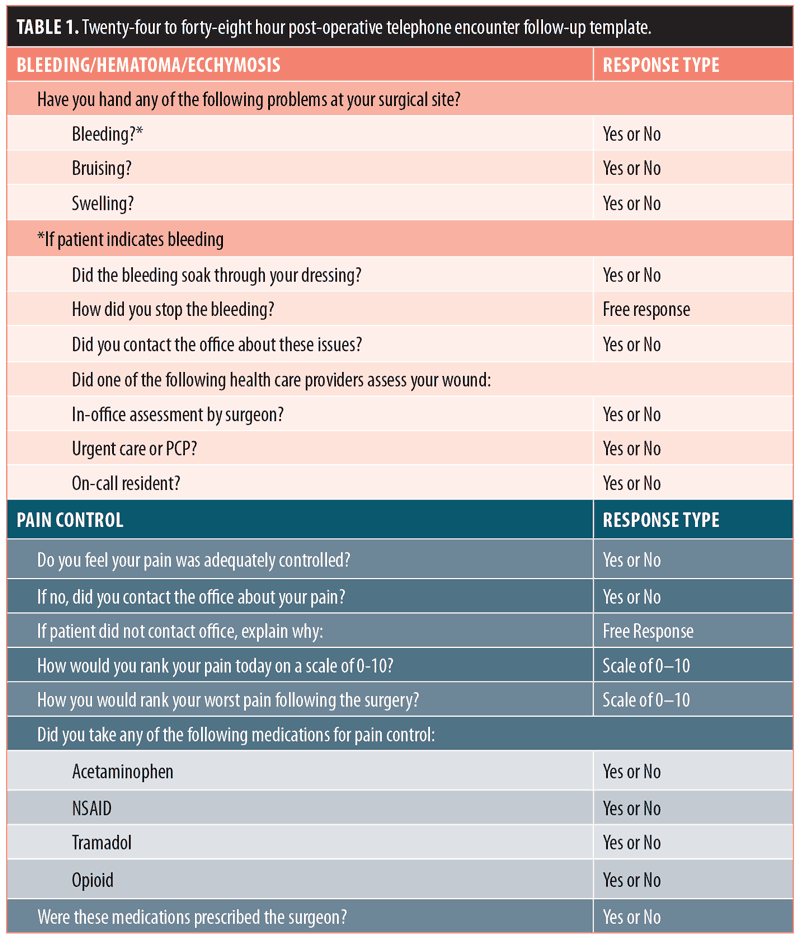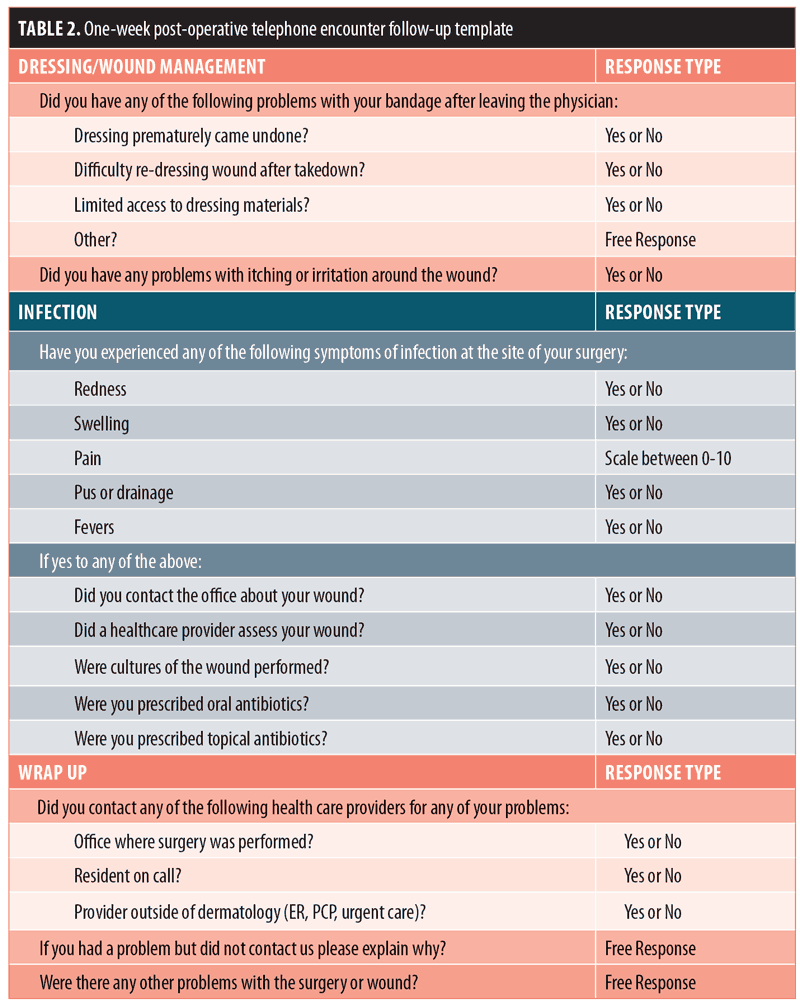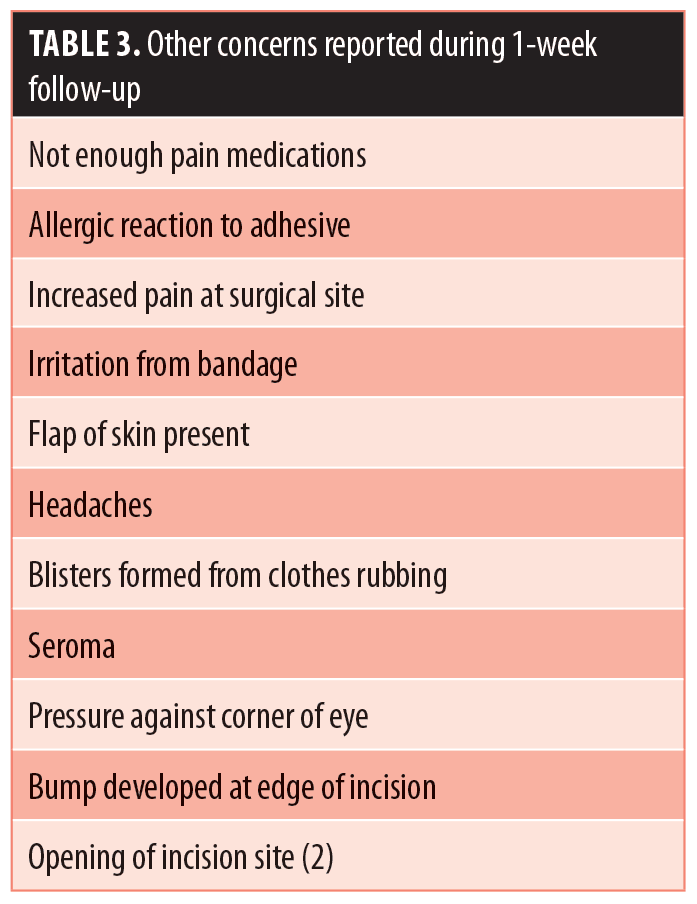 by Brayden Forbes, MD; Aaron M. Secrest, MD, PhD; Matthew Q. Hand MD; and Mark J. Eliason, MD
by Brayden Forbes, MD; Aaron M. Secrest, MD, PhD; Matthew Q. Hand MD; and Mark J. Eliason, MD
Drs. Forbes, Secrest, Hand, and Eliason are with the Department of Dermatology at the University of Utah in Salt Lake City, Utah. Dr. Secrest is with the Department of Population Health Sciences at the University of Utah.
Abstract: Objective. The purpose of this study was to describe and evaluate the process of implementing a routine telephone follow-up (TFU) system for capturing postoperative complications or concerns among Mohs micrographic surgery (MMS) patients. Design. Postoperatively, patients were called twice: 1) within 24 to 48 hours to assess bleeding, swelling, and pain control; and 2) at one week to assess wound care, signs of infection, or other concerns. Setting. The study took place in a single-institution academic dermatology department with five fellowship-trained Mohs surgeons. Participants. Study subjects included patients undergoing MMS during a two-month period. Measurements. Data regarding completed TFU rate, time to complete calls, and patient-reported complication rates were collected and analyzed. Results. Of 349 MMS patients, 263 (75.4%) were successfully contacted during the 24- to 48-hour follow-up window and 232 (66.5%) at the one week interval. Major complication rates were 0.4 percent (n=1) for bleeding and 0.4 percent (n=1) for infection; both were treated by their respective Mohs surgeon. Timed calls averaged approximately three minutes per encounter. Conclusion. TFU is practical and efficient for assessing and mitigating MMS postoperative complications.
Keywords: Dermatologic surgery, post-operative follow-up, Mohs micrographic surgery, surgical complications
J Clin Aesthet Dermatol. 2018;11(7):36–39
Introduction
Mohs micrographic surgery (MMS) is an increasingly common and effective outpatient procedure performed in both academic and private dermatology clinics with low complication rates.1–5 Identifying both major and minor postoperative complications is necessary to improve the quality of Mohs-based surgical care.6 No established standards currently exist for regular patient follow-up after MMS.
Identification and quantification of Mohs complications rely primarily on patient-initiated reporting. If patients seek care for complications from other more accessible providers (e.g., emergency departments or urgent care facilities), complication management might not be ideal and the treating surgeon might not become aware of the complication. Prior to this quality improvement project, our institution lacked a mechanism for uniformly capturing postoperative data. We present our process for developing and implementing a systematic, time- and cost-efficient process for Mohs telephone follow-up (TFU) to determine population-based complication rates and identify areas for improvement.
Methods
All patients undergoing MMS over the two-month intervention period received standard, written instructions detailing after-visit wound care protocols. While postoperative assessment varied by anatomic site, surgeon, and patient, follow-up was only scheduled in a clinic at the discretion of the surgeon upon completion of the procedure, most often for high-risk flaps or grafts or for nondissolvable suture removal. Otherwise, attempts were made to contact all patients via phone: once within the first 48 hours after surgery and again at the one-week interval. The TFU script was designed by Mohs surgeons, and all calls were made by a senior medical student under the supervision of board-certified dermatologists on an as-needed basis. The 24- to 48-hour follow-up call focused primarily on bleeding, pain, ecchymosis and edema (Table 1), whereas one-week follow-up centered on pain, infection, and wound management issues (Table 2). Branched chain logic centered on yes/no responses efficiently captures data without sacrificing detail. A positive response led to additional focused questions to gather details about an event. A negative response closes that line of questions and shifts to the next line of questions.


Patients were also asked open-ended questions to explore any concerns that the focused questions might not have addressed. Two telephone attempts were made for each patient. Patients who completed a one-week in-clinic follow-up appointment (for suture removal or other pre-planned indication) were asked the same one-week follow-up questions in person rather than by telephone. This study was exempted by the University of Utah Institutional Review Board.
Results
During the two-month study period, 349 patients underwent MMS for a total of 698 attempted TFU calls. A total of 263 (75.4%) and 232 (66.5%) patients were reached with post-operative TFU encounters at 24 to 48 hours and at one week, respectively. A random sample of TFU calls were timed at approximately three minutes per encounter.
Follow-up (24–48 hours). Bleeding, bruising, and swelling. Of 263 patients contacted, 62 (23.6%) reported complications: 18 (6.8%) with bleeding issues, 17 (6.5%) with bruising, and 27 (10.3%) with swelling issues. No bruising or swelling required additional treatment. Of the 18 with bleeding, 17 reported spontaneous resolution or hemostasis with direct pressure alone, two contacted the MMS clinic, and one (0.4%) returned to the office for intervention (cautery).
Pain control. Pain was reported as adequately controlled in 255 (97.0%) patients. Of the eight patients who endorsed uncontrolled pain, only one contacted the surgeon. The average pain level, on a scale from 0 to 10 (10 being worst) on the day of surgery was 3.6, compared to 1.9 at the 24 to 48 hour follow-up. Most patients (167 [63.5%]) reported using some form of pain medication, usually acetaminophen (45% of all pain medications) or an over-the-counter (OTC) nonsteroidal anti-inflammatory drug (22%). Thirty (18%) patients used a prescription opioid alone or in some combination with OTC analgesics; 57 percent of these patients used opioids not prescribed by their Mohs surgeon.
Follow-up (one week). Dressing/wound management. Five of 232 (2.2%) patients with one-week follow-up TFU encounters reported their initial dressing coming undone prematurely (before 48 hours). Twelve (5.2%) patients reported difficulty redressing the wound after removing the initial bandage, and four (1.7%) stated they had limited access to dressing materials. Fifty-three (23%) patients endorsed itching (n=43) or irritation (n=10) at the wound site.
Infection. Eighteen (7.8%) patients reported subjective findings of infection (Table 2); four contacted the MMS clinic about this. Of these, one (0.4%) patient had the wound checked by the surgeon and was prescribed oral antibiotics with the presumptive diagnosis of a local wound infection; no wound culture was performed.
Other findings. Seven (3.0%) patients reported contacting the MMS clinic overall for any concern. No patients reported contacting a primary care provider, urgent care, or emergency department for any Mohs-related concern. Patients were asked to freely describe any additional problems experienced with their wound (Table 3). Patients who endorsed a Mohs-related concern but did not contact any healthcare providers were asked to explain why. Responses include “not concerned about it,” “symptoms were clearing,” “already had follow-up appointment scheduled,” and “learned I was allergic to the bandage.” Patients endorsing any ongoing self-identified complications were asked to return to clinic for follow-up.

Discussion
Postoperative clinic-initiated telephone calls using a vetted and systematic template provide a more accurate picture of MMS patients complications. Once identified, problems can be proactively addressed at the MMS visit and/or in after-visit summaries and wound care instructions. Based on our results, patients can have postoperative evaluation through TFU without compromising their safety. By eliciting a postoperative history over the phone, clinics can address concerns prior to adverse events. This strategy would not only maintain the wellbeing of the patients but would potentially preserve clinic time for seeing regularly scheduled patients. Implementation is relatively simple and can be achieved efficiently by clinic staff, with a uniform process for relaying urgent or severe complications directly to the surgeon. Additionally, the time required to complete a follow-up call was minimal (about 3 minutes). Of the completed TFU calls, nearly all were direct conversations with the patient. Only a minority (?1%) of calls necessitated a spouse or other family member to answer on behalf of the patient. Most often this was due to hearing loss. This likely had little significance with regard to accurate assessment of post-operative complications.
In-office appointments for postoperative follow-up are often the gold standard of care in surgery. However, this creates increased demand on clinic time and resources, resulting in increased costs for both patient and clinic. “Value-based” healthcare aims to reduce nonvalue-added healthcare spending.13 TFU is an alternative to in-office visits. It is cost-effective and time-efficient at identifying postoperative complications and increases patient satisfaction.7–12 In low-risk general surgery patients, TFU has also been used as a triage tool to reduce clinic time and resources.10 Data on TFU use with MMS are limited. Standardizing postoperative complication data collection allows for comparisons between dermatologic surgeons and other surgical specialties.6 Though not measured in this study, a theoretical reduction in patient costs exists related to decreased time lost and travel costs to the clinic. In our experience with TFU, these calls provided the opportunity to reassure or advise patients regarding any symptoms they were experiencing. We believe reducing complication rates and minimizing in-person visits will free up more resources to improve MMS access.14 Additionally, given the low reported complication rates for MMS, similar to those seen in our cohort, TFU could be more efficient and cost-effective without compromising patient safety.3,4
Regarding postoperative pain, among our cohort, only one patient contacted the Mohs clinic for inadequate pain control, yet 18 percent (n=30) used a prescription opioid. This result illustrates how TFU can identify which types of procedures/repairs tend to require prescription opioids and provides a more accurate measure of postoperative pain for in-clinic discussion of postoperative expectations. Without TFU, physicians might have selection bias regarding patient pain level, since they might otherwise only prescribe pain medication to the few patients who actually make the effort to call in with uncontrolled pain.
Limitations. Limitations include time constraints for making and returning telephone calls. We only had a single individual making calls at various times of day. Additionally, for patients who could not be reached initially, multiple calls were attempted using alternate phone numbers in the medical record, resulting in excessive time spent making calls. Our follow-up rate would likely improve with several medical staff making calls from a known clinic telephone number provided in the patients’ after-visit summary provided to the patient at consistent times of the day. Also, apprising patients of the follow-up calls at the time of their surgery would also increase telephone follow-up completion rates. Given the dichotomous (yes/no) nature of our TFU, encounter notes can easily be templated to electronic health records, allowing efficient and consistent information gathering.
Based on these proof-of-concept findings, the utility of TFU should be evaluated with a randomized study. A control group would provide comparative data for passively-identified complications. While we did not specifically inquire of every possible surgery-related complication, we asked a free-response question regarding any self-identified complications. Stratifying by patient demographics, repair type, and tumor size will aid in assessing TFU utility but were not analyzed in this study.
Conclusion
Medical staff in MMS practices can effectively and efficiently implement scripted TFU encounters due to low MMS complication rates. Implementation in both academic and private practices is feasible, given an average three-minute call time. A TFU system can preserve clinic time for seeing scheduled patients without compromising the safety of postoperative patients. Furthermore, complication data obtained through TFU can provide valuable direct feedback to individual Mohs surgeons for quality improvement.
References
- Cook JL, Perone JB. A prospective evaluation of the incidence of complications associated with Mohs micrographic surgery. Arch Dermatol. 2003;139(2):143–152.
- Aasi SZ, Leffell DJ. Complications in dermatologic surgery: how safe is safe? Arch Dermatol. 2003;139(2):213–214.
- Alam M, Ibrahim O, Nodzenski M, et al. Adverse events associated with mohs micrographic surgery: multicenter prospective cohort study of 20,821 cases at 23 centers. JAMA Dermatol. 2013;149(12):1378–1385.
- Hussain W, Affleck A, Al-Niaimi F, et al. Safety, complications and patients’ acceptance of Mohs micrographic surgery under local anaesthesia: results from the U.K. MAPS (Mohs Acceptance and Patient Safety) Collaboration Group. Br J Dermatol. 2017;176(3):806–808.
- Merritt BG, Lee NY, Brodland DG, et al. The safety of Mohs surgery: a prospective multicenter cohort study. J Am Acad Dermatol. 2012;67(6):1302–1309.
- Council ML, Alam M, Gloster HM, Jr., et al. Identifying and defining complications of dermatologic surgery to be tracked in the American College of Mohs Surgery (ACMS) Registry. J Am Acad Dermatol. 2016;74(4):739–745.
- Car J, Sheikh A. Telephone consultations. BMJ. 2003;326(7396):966–969.
- Hafiji J, Salmon P, Hussain W. Patient satisfaction with post-operative telephone calls after Mohs micrographic surgery: a New Zealand and U.K. experience. Br J Dermatol. 2012;167(3):570–574.
- Delichatsios H, Callahan M, Charlson M. Outcomes of telephone medical care. J Gen Intern Med. 1998;13(9):579–585.
- Kummerow Broman K, Roumie CL, Stewart MK, et al. Implementation of a telephone postoperative clinic in an integrated health system. J Am Coll Surg. 2016;223(4):644–651.
- Gray RT, Sut MK, Badger SA, Harvey CF. Post-operative telephone review is cost-effective and acceptable to patients. Ulster Med J. 2010;79(2):76–79.
- Hwa K, Wren SM. Telehealth follow-up in lieu of postoperative clinic visit for ambulatory surgery: results of a pilot program. JAMA Surg. 2013;148(9):823–827.
- Damberg CL, Sorbero ME, Lovejoy SL, et al. Measuring success in health care value-based purchasing programs: findings from an environmental scan, literature review, and expert panel discussions. Rand Health Q. 2014;4(3):9.
- Pal B. Following up outpatients by telephone: pilot study. BMJ. 1998;316(7145):1647.

